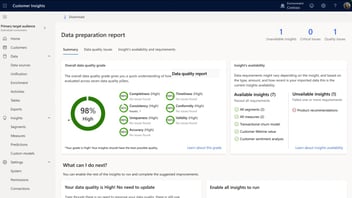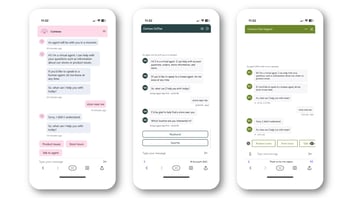Revolutionising Growth: Cost-Effective Strategies for the Customer Acquisition Model to Attract Ideal Customers

Successful customer acquisition models don’t just mean attracting new prospects. To build a sustainable customer acquisition model, you need to understand who your ideal customers are, engage with them meaningfully, and create long-term value. Data-driven targeting, automation, and personalisation can help you reduce acquisition costs and tailor the experience to attract the right customers.
In this blog, David Catmur-Lloyd, Consultancy Director at Crimson, explores how organisations can leverage automation and AI-driven strategies to improve customer experience and reduce customer acquisition costs.
Why your customer acquisition model matters
Customer acquisition is more than just numbers, it’s about acquiring the right customers efficiently and cost-effectively. Organisations often mistakenly rely on high-volume approaches that focus on quantity over quality. But in a world driven by data and AI, the focus is shifting to creating personalised, intimate experiences that resonate with high-value customers. Understanding customer personas, optimising targeting strategies, and leveraging technology can transform your acquisition costs into an investment with measurable returns, forming a solid customer acquisition strategy.
Analysing your acquisition model
· Where are your leads coming from?
· What is your conversion rate across different tools?
· What types of customers are converting most?
A comprehensive customer acquisition plan should address these questions to ensure a well-rounded approach.
Customer acquisition metrics
Customer acquisition metrics are essential for measuring the effectiveness of a customer acquisition strategy. These metrics provide insights into the performance of various acquisition channels, tactics, and strategies, enabling organisations to make data-driven decisions to optimise their customer acquisition efforts.
Understanding customer acquisition cost (CAC)
Customer Acquisition Cost (CAC) is a critical metric that measures the cost of acquiring a new customer. It is calculated by dividing the total cost of a marketing campaign and sales expenses by the number of new customers acquired. CAC is essential for organisations to ensure that their acquisition strategies are financially sustainable. A high CAC can indicate that an organisation is spending too much to acquire customers, which can hurt profitability.
Exploring customer lifetime value (CLV)
Customer Lifetime Value (CLV) represents the total value a customer brings to an organisation over their lifetime. It is crucial to compare CLV to CAC to ensure that acquiring new customers is profitable.
The ratio of CLV to CAC should be between 3:1 and 5:1. If your ratio is less than 3:1, your customer acquisition strategies are ineffective; more than 5:1 could mean you might be missing out on growth by not investing enough in marketing and sales.
Acquisition rate and other relevant metrics
The acquisition rate is the percentage of potential customers who become actual customers. Conversion rate refers to the percentage of visitors or leads who complete a desired action, such as purchasing, signing up for a newsletter, or filling out a form. Other relevant metrics include engagement rates and the effectiveness of individual channels. These metrics contribute to a comprehensive understanding of customer acquisition performance.
Understanding your customer personas
One of the most common mistakes organisations make is failing to define their ideal customer personas. Without this clarity, marketing efforts can be misdirected, leading to wasted advertising spend and poor conversion rates. You must understand their needs and pain points, how they want to interact with you, and which of your value propositions resonate with them most.
Research-backed customer personas enable businesses to:
· Deliver targeted, relevant messages which lead to higher conversion rates.
· Improve engagement rates and customer experience
· Allocate resources more efficiently
· Build loyalty through personalised interactions
Defining high-value customers
Not every lead is created equal. Take the time to determine what high-value customers look like for your organisation. Consider factors such as their buying behaviour, challenges, and goals.
You can pinpoint and prioritise customer segments with the highest conversion rates and lifetime value using data analytics. Facebook and Google Ads allow you to target lookalike audiences similar to your best customers.
Building a refined customer acquisition model means focusing on leads aligning with your brand’s value proposition, ensuring higher conversion rates.
Optimising your customer acquisition with Crimson
Crimson helps organisations integrate automation tools into their marketing processes, resulting in faster response times, reduced acquisition costs, and improved lead nurturing.
Crimson recently implemented an automated lead-generation system for a Scottish University. High-intent prospects were engaged early in their decision-making by focusing on ideal student profiles. The project boosted enrolments and re-directed resources to the right students.
To enhance their ability to engage with their existing contact base at the right time, a legal firm partnered with Crimson to implement Microsoft Dynamics Customer Journeys (Real-time Marketing). Crimson facilitated the transition by importing their contact database from outdated, siloed systems, configuring a modern compliance centre to ensure all communications were solicited and relevant, and providing comprehensive training on Customer Journeys. This training enabled their team to design tailored communication journeys for various topics of interest. As a result, the firm now benefits from a sophisticated marketing system that allows them to communicate more effectively with their contacts and deliver timely, relevant market updates.
How automation and AI are transforming customer acquisition cost
Automation enables marketing teams to focus on strategic planning and creative problem-solving. AI-powered tools can perform tasks such as:
· Data Entry and Segmentation: Get better insights into customer demographics
· A/B Testing: Quickly optimise campaigns by evaluating what works best
· Lead Nurturing: Tools like automated email campaigns ensure ongoing customer touchpoints.
· Content Creation: Create compelling, on-brand content such as blogs and social media posts with AI-powered marketing tools.
· Chatbots & Conversational AI: AI-driven chatbots provide instant responses to customer queries, improving engagement without increasing costs.
· White space and Up-selling: AI can recommend upselling of products or services based on customer behaviours on your website.
· Automate Ad Bidding: Google Ads and Facebook’s AI-powered bidding optimises spend for conversions rather than just clicks.
· Dynamic Retargeting: Show tailored ads based on users’ past interactions (e.g., abandoned baskets, product views).
By analysing your customer journey and personas, you can implement automation that delivers real results while saving you time. When combined with human interaction at key stages, this approach can be a game-changer for a successful customer acquisition strategy.
Leveraging predictive analytics
Predictive analytics gives brands the ability to predict customer behaviours and target them at the right moment. Imagine being able to anticipate what your customers want before they even know they want it. AI-enabled platforms like Microsoft Dynamics 365 provide these capabilities by analysing purchasing patterns and behavioural data.
Predictive analytics is powerful, but it still has its limitations. For example, it can’t tell if you’ve purchased elsewhere. Consumer behaviour isn’t always predictable, sometimes, people browse simply out of curiosity. External factors also play a huge role in shaping patterns: rising fuel prices may lead to a surge in petrol purchases, or increasing education costs could result in fewer students enrolling. As predictive analytics evolves, it will become better at recognising these nuances.
Establishing a data-driven approach
Good data governance is essential for efficient, compliant, and high-performing customer acquisition strategies. It ensures accurate targeting, regulatory compliance, sales-marketing alignment, effective predictive analytics, and maximised ROI. Without it, organisations risk poor customer experiences, wasted resources, and lost opportunities.
Tackling data silos
Many organisations operate with fragmented data, limiting their ability to view customers holistically. Consolidating this data into integrated systems ensures accurate insights about potential customers and provides consistent tracking across their journeys. AI and advanced analytics allow companies to make better data-driven decisions, ensuring they invest in the right acquisition channels.
Benefits of a data-driven approach
· Reduced Customer Acquisition Cost (CAC): By directing budgets to high-performing channels, resources are invested where they matter most
· Refined Messaging: Up-to-date customer insights create opportunities for hyper-personalisation based on real-time data
· Reduced Waste: Focus on qualified leads boosts efficiency and lowers acquisition costs.
Balancing acquisition and retention
Acquiring a new customer can cost five times more than customer retention. Businesses often make the mistake of pouring resources into acquiring customers without making similar investments to keep them.
A customer-centric approach ensures that businesses not only attract but also retain high-value customers. Strategies include:
· Brand Ambassadors: Identify loyal customers who are passionate about your brand and encourage referrals.
· Seamless onboarding: Ensure a smooth start to your customer’s relationship with your brand.
· Engagement through personalisation: Keep customers coming back by tailoring offers and content specifically to their needs.
For example, personalised loyalty programmes using AI reduce churn and identify opportunities for up-selling.
Building exceptional customer experiences
Customers expect brands to cater to their individual needs and preferences. Hyper-personalisation, powered by AI, enables businesses to deliver tailored content that aligns with customers’ journeys.
Imagine sending a prospect an email featuring insights into the very problem they’re currently trying to solve. Crimson leverages tools like Microsoft Dynamics Customer Insights to achieve such capabilities, ensuring every interaction is meaningful.
· Personalised Website Experiences: Display different homepage banners, product recommendations, or pricing based on user data.
· Adaptive Email Marketing: Use dynamic email content that adjusts based on user behaviour (e.g., discount offers for basket abandoners).
· Segmented Ads & Messaging: Create different ad creatives for different customer segments to improve engagement.
· AI-Driven Content Suggestions: Use AI to suggest articles, videos, or guides tailored to customer interests.
Creating authentic content
Beyond personalisation, creating authentic experiences is just as important. Build trust with customers by offering value upfront through webinars, free resources, or targeted content. Authenticity impacts loyalty, and loyal customers cost less to acquire over time. Customers change and evolve, and so should your value proposition. Weave those promises into the brand story and reflect them in all marketing executions.
Steps to optimise your customer acquisition strategy

The future of customer acquisition
The future of customer acquisition lies in leveraging data and technology to build value-driven, sustainable growth models. While AI currently serves as the co-pilot, it will soon take the driver’s seat, charting new paths autonomously, without the need for manual intervention.
Elevate your customer acquisition model
Crimson is uniquely positioned to help organisations optimise customer journeys through innovative, tech-enabled solutions. Book your discovery call now.



